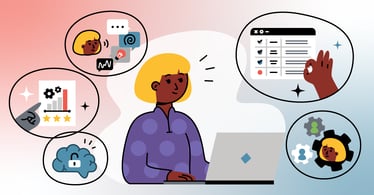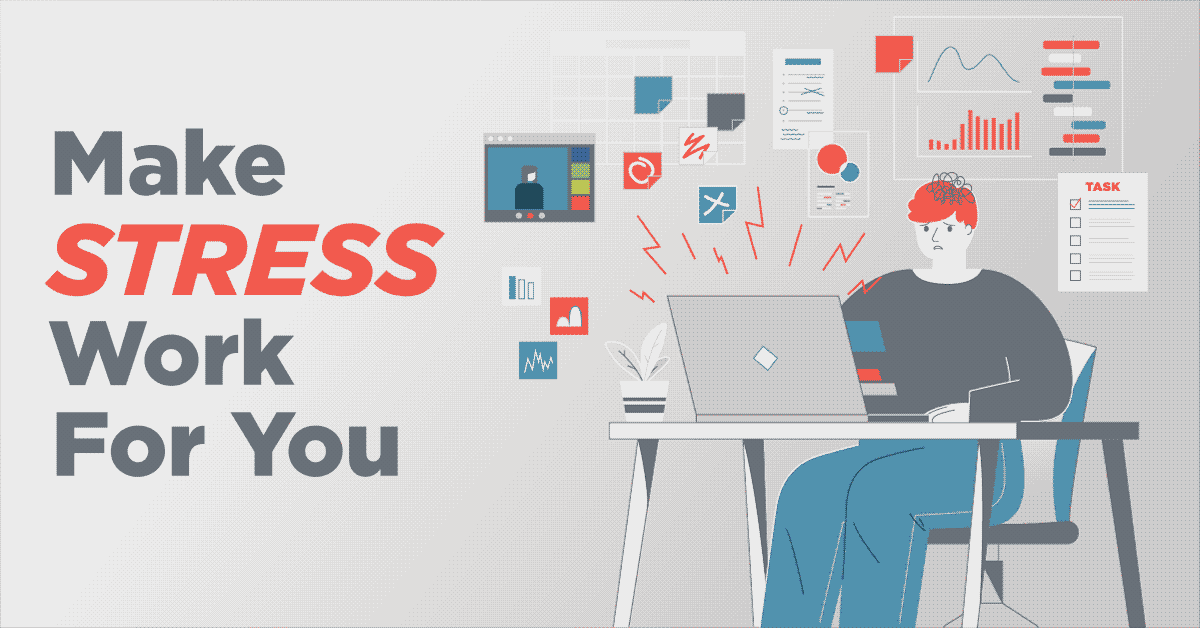The 12 Driving Forces Under Pressure: Each Driver At Extremes
The factors that motivate us are obviously very personal and important to individuals, but sometimes you need to look at the bigger picture, especially if you're in a stressful situation. The 12 Driving Forces assessment is a great resource for better understanding.
Here is what each driver can look like at its most extreme and what you can do to stay even-keeled.
What Does Instinctive Mean in The 12 Driving Forces?
People with an Instinctive driver use past experience, intuition, and real-time research to solve an immediate need.
An Instinctive person wants only the knowledge necessary to succeed in the moment. They pursue knowledge on a "need to know" basis and choose to pursue the knowledge they're interested in rather than try to gain a general understanding. They'll choose cliff notes over the textbook.
Instinctive Under Pressure: Stressed Out and Short-Sighted
In stressful situations, people with Instinctive drivers are ready to par down to the essentials.
Unfortunately, their ability and willingness to reduce their flow of knowledge to the 'need to know' basis can become more of a problem in the long run. This can be viewed by others as an attempt to take shortcuts.
Instinctive people also might become frustrated with others who need more information in a high-pressure situation.
While Instinctive people might feel like their peers require more information than necessary, they need to be careful not to disregard others' need for a full scope of information.
What Does Intellectual Mean in The 12 Driving Forces?
People with an Intellectual driver acquire knowledge, discover, and find opportunities to learn wherever they are. They want all available knowledge on the subject simply to understand it, regardless of the direct application. They like learning for the sake of learning!
Intellectual Under Pressure: Losing the Bigger Picture
In stressful situations, people with Intellectual drivers avoid acting until they've gathered all the information they can. They want all the facts before moving forward, but that just isn't possible in every situation—- sometimes, you need to act first and analyze later!
To an outside observer, this hesitancy might look like an Intellectual person dragging their feet. Considering every possible outcome just isn't possible a lot of the time and can lead to worrying and spiraling, which will make a stressful situation even worse.
What Does Selfless Mean in The 12 Driving Forces?
People with a Selfless driver are driven by completing tasks for the sake of completion, with little expectation of personal return.
Selfless people contribute to a project with minimal expectation of personal return and are focused on accomplishing tasks for the sake of accomplishment. They tend to focus on the greater good of a task or project versus the return on the investment of their resources.
Selfless Under Pressure: Nose Too Much To The Grindstone
When situations get difficult, people with a Selfless driver can have a hard time adapting. Their focus hones in on task completion and little else, which can lead to missed deadlines and missed points from more adaptable team members.
Task completion is important but it needs to serve a larger vision; Selfless people can zoom in too far under pressure and lose sight of the bigger picture.
What Does Resourceful Mean in The 12 Driving Forces?
People with a Resourceful driver are driven by practical results, maximizing both efficiency and returns for their investments of time, talent, energy, and resources.
They are passionate about returns on investment and want to build a framework that maximizes the time and talent invested in a project.
Resourceful Under Pressure: Calculating and Cold
When Resourceful people are in high-pressure situations, they fall back on viewing everything and everyone through a lens of efficiency. This can cause them to overemphasize profit over people, which will cause the people around them to feel resentful and unappreciated.
Not considering the people involved in getting an ROI is an easy mistake for someone with a Resourceful driver to make; in their minds, they're looking out for the best interests of all involved by trying to ensure the success of a project. However, this stress reaction can increase the stress of those around them.
What Does Harmonious Mean in The 12 Driving Forces?
The Harmonious person has a subjective focus on the experience and the totality of their surroundings — often preferring form over function and seeking to beautify and harmonize the world around them.
Beyond beauty, a Harmonious driver looks at the big picture. This person may like to complete projects in order to see the full picture seamlessly evolving over time and create an impactful experience.
Harmonious Under Pressure: Details Over Delivery
When Harmonious people are under a lot of stress, they end up getting too caught up on details that don't matter when the deadline is approaching.
They can get easily frustrated by a perceived lack of cohesion on the part of others involved, but they usually aren't trying to 'zoom out' and see the bigger picture.
This tendency to dial in can cause communication issues with others who just aren't seeing what a Harmonious person is seeing. If they don't fully communicate their vision, details are going to continue to be lost and their frustration will only increase.
What Does Objective Mean in The 12 Driving Forces?
People with an Objective driver are driven by the functionality and objectivity of their surroundings. They are not distracted in environments filled with chaos and have the ability to view everything in pieces and focus on one piece at a time.
They prefer to break a whole project or idea down into measurable parts and look at them independently of one another.
Objective Under Pressure: Spliced Investment
Even on the other side of the Surroundings Objective people experience a similar response on the opposite side of the spectrum. In stressful situations, people with an Objective driver stop seeing the bigger picture because they're too focused on the functional measurable parts of a project, not the larger effect and response.
They might be completing tasks on time, but their Objective nature doubles down under pressure. Their actions can lack cohesion and overall understanding of the experience of others and they have a hard time understanding what the issue is— the work is done in their eyes.
What Does Altruistic Mean in The 12 Driving Forces?
Altruistic people are driven to assist others for the satisfaction of being helpful or supportive.
They hold the firm belief that all people should have the opportunity to be the best they can be and will instinctively notice others in need and give generously of their time, talent, and resources with no expectation of personal return.
People with an Altruistic driver will also sacrifice their personal gain in a situation if the outcome is detrimental to others, and are prone to giving in relationships by focusing only on the benefits of their actions to others.
Altruistic Under Pressure: Spread Too Thin
In stressful situations, people with an Altruistic driver become especially concerned with their contributions.
They begin to worry and question if they're doing enough good in their role and through their work. Altruistic people will try to seek out meaning through helping others in each project and can become distressed if they can't find it.
This also can cause people with an Altruistic driver to devalue work that doesn't relate back to helping others, which unintentionally but unfortunately can isolate their team members who are more focused on results.
What Does Intentional Mean in The 12 Driving Forces?
People with an Intentional driver are people who are driven to assist others for a specific purpose, not just for the sake of being helpful or supportive.
This doesn't mean that Intentional people don't care about others! It simply means that they are careful and strategic with who they help and why. They need at least a win/win solution to invest their time.
Intentional Under Pressure: Biased Against Others
In stressful situations, Intentional people narrow down their scope and focus on helping others only if they see a personal benefit. This isn't necessarily a bad thing but it can lead to a communication breakdown when people with an Intentional driver are approached by others who want to help everyone with a need.
Under pressure, Intentional people don't want to help those who will not help themselves! They aren't looking for compromise, which can result in them looking for problems and conflicts instead. If someone approaching them doesn't consider what an Intentional individual cares about, it's likely their request will be disregarded.
What Does Commanding Mean in The 12 Driving Forces?
Commanding people value status and public recognition and they assert control over their freedom and destiny. They are driven to create winning strategies and are passionate about creating an enduring legacy through their work.
If someone is Commanding, that doesn't necessarily mean they are aggressive or direct in the workplace. It simply means that they want a hand in creating their own path forward and prefer to take on roles that receive credibility and recognition.
Commanding Under Pressure: Tunnel Vision Moving Forward
When people with a Commanding driver are under pressure, they can become very protective of themselves and their goals and plans. Commanding people are highly driven by the concept of controlling their own destiny and don't want to take orders or devote their time to another person's cause in heightened situations.
This can lead to mistrust within a team and a lack of comradery. If a Commanding person is taking a "my way or the highway" approach to achieving goals and communicating, the rest of the team might feel disregarded and left behind.
What Does Collaborative Mean in The 12 Driving Forces?
People with a Collaborative driver are driven by being in a supporting role and contributing with little need for individual recognition.
They focus on their contribution versus advancing their position and enjoy working behind the scenes and getting things done. They thrive when working closely with others and love contributing to a mutual goal.
Collaborative Under Pressure: Too "Go With The Flow'
In stressful situations, Collaborative people need to look out for their own ability to go with the flow. Their default is to help the group succeed and move forward, but this means they might agree under pressure when they know better.
In the worst-case scenario, this can result in Collaborative people following a leader or cause to their own detriment or pressure when to act against their best interests.
What Does Structured Mean in The 12 Driving Forces?
Structured people are driven by traditional approaches, proven methods, and abiding by a defined system for living. They prefer to show their work and want you to do the same; don't ask them to do something without explaining the structure and your reasoning behind it! They thrive when contributing to building a defined system and approach.
Structured Under Pressure: No New Ideas
In extreme situations, Structured people want to return to what they know. They can become reliant on their principles and beliefs to guide their actions and decisions, and have a tendency to become adamant and protective of those beliefs as they try to keep things in check.
This protectiveness makes sense given their motivations but can also cause a gridlock of innovation. If you're always looking at how it's been done, you'll entirely miss how it could be done in the future. Structured people might miss out on opportunities to thrive in the future or even on new beliefs and systems that fit in well with your own.
What Does Receptive Mean in The 12 Driving Forces?
Receptive people are driven by new ideas, methods, and opportunities that fall outside a defined system for living.
People with a Receptive driver are always looking for new ways to accomplish routine tasks and like to set their own path to guide and direct their actions. They tend to get creative when interpreting systems and will adopt aspects of them if they see a benefit.
Receptive Under Pressure: Causing Chaos
Receptive people have an ability to pivot and find new ways to work but this can spiral out of control in extreme situations. By pinging from idea to idea, this driver causes nothing to get done because Receptive people are thinking of all the ways they could complete a task instead of actually completing the task.
Under stress, Receptive people can also get stubborn. You might not assume this initially because of their free-wheeling nature, but this headstrong tendency can be activated by the idea that 'we should just do it the way it's always been done'. Receptive people can reject that notion and chase the thrill of a new method or approach, even if it's not the right call.
What To Do With Drivers Under Pressure
Stress is inevitable but your reactions don't have to launch out of your control! No matter what motivates you, there are ways for you to keep your cool under pressure.
First of all, make sure to stay aware of your reactions. Just knowing how you're feeling internally is half the battle when it comes to managing emotions!
This is where a multi-science approach will be helpful; if you have well-developed self-awareness, you'll be able to more easily check yourself and keep an internal eye on how you're feeling.
Focus on clear communication!
Most of these extreme reactions are a result of focusing on what matters to an individual and not necessarily what matters to the larger team. By expressing your thoughts and staying open to others, you can make sure everyone is on the same page and that you're communicating clearly.
If you're feeling yourself withdrawing, make sure to learn from different styles. By going to the opposite side of each continuum, you can pick up on ways to cope that you might not have naturally considered. These insights will give you a new way forward or at least help you consider the perspectives of others as you navigate stressful scenarios.
To know more about each of The 12 Driving Forces, check out these resources:
- The 12 Driving Forces in Depth: Knowledge
- The 12 Driving Forces in Depth: Utility
- The 12 Driving Forces in Depth: Surroundings
- The 12 Driving Forces in Depth: Others
- The 12 Driving Forces in Depth: Power
- The 12 Driving Forces in Depth: Methodologies
If you want to harness the power of The 12 Driving Forces for your team, TTI SI can help. Contact us here to get started revealing human potential.

Darcy Sisson
Darcy loves to listen to the stories of others, and as a Solution Consultant, helps in any capacity that she can to bring clarity and solutions to the TTI SI network.




![3 Workplace Scenarios to Avoid if Self-Regulation is NOT Your Strong Suit [Infographic] | Emotional Intelligence](https://blog.ttisuccessinsights.com.au/hs-fs/hubfs/TTISI%20Blog%20Images%20(Canva)/3%20Workplace%20Scenarios%20to%20Avoid%20if%20Self-Regulation%20is%20NOT%20Your%20Strong%20Suit%20%5BInfographic%5D.png?width=374&name=3%20Workplace%20Scenarios%20to%20Avoid%20if%20Self-Regulation%20is%20NOT%20Your%20Strong%20Suit%20%5BInfographic%5D.png)
0 Comments